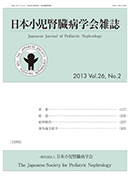Volume 26, Issue 2
Displaying 1-22 of 22 articles from this issue
- |<
- <
- 1
- >
- >|
Original Articles
-
2014 Volume 26 Issue 2 Pages 177-181
Published: 2014
Released on J-STAGE: June 14, 2014
Download PDF (298K) -
2014 Volume 26 Issue 2 Pages 182-186
Published: 2014
Released on J-STAGE: June 14, 2014
Download PDF (587K) -
2014 Volume 26 Issue 2 Pages 187-193
Published: 2014
Released on J-STAGE: June 14, 2014
Download PDF (1207K) -
2014 Volume 26 Issue 2 Pages 194-203
Published: 2014
Released on J-STAGE: June 14, 2014
Download PDF (492K)
Reviews
-
2014 Volume 26 Issue 2 Pages 205-212
Published: 2014
Released on J-STAGE: June 14, 2014
Download PDF (774K) -
2014 Volume 26 Issue 2 Pages 213-219
Published: 2014
Released on J-STAGE: June 14, 2014
Download PDF (805K) -
2014 Volume 26 Issue 2 Pages 220-226
Published: 2014
Released on J-STAGE: June 14, 2014
Download PDF (1797K) -
2014 Volume 26 Issue 2 Pages 227-231
Published: 2014
Released on J-STAGE: June 14, 2014
Download PDF (1415K) -
2014 Volume 26 Issue 2 Pages 232-241
Published: 2014
Released on J-STAGE: June 14, 2014
Download PDF (2869K) -
2014 Volume 26 Issue 2 Pages 242-244
Published: 2014
Released on J-STAGE: June 14, 2014
Download PDF (284K) -
2014 Volume 26 Issue 2 Pages 245-249
Published: 2014
Released on J-STAGE: June 14, 2014
Download PDF (688K) -
2014 Volume 26 Issue 2 Pages 250-255
Published: 2014
Released on J-STAGE: June 14, 2014
Download PDF (606K)
Case Reports
-
2014 Volume 26 Issue 2 Pages 257-261
Published: 2014
Released on J-STAGE: June 14, 2014
Download PDF (1129K) -
2014 Volume 26 Issue 2 Pages 262-267
Published: 2014
Released on J-STAGE: June 14, 2014
Download PDF (804K) -
2014 Volume 26 Issue 2 Pages 268-273
Published: 2014
Released on J-STAGE: June 14, 2014
Download PDF (615K) -
2014 Volume 26 Issue 2 Pages 274-277
Published: 2014
Released on J-STAGE: June 14, 2014
Download PDF (771K) -
2014 Volume 26 Issue 2 Pages 278-284
Published: 2014
Released on J-STAGE: June 14, 2014
Download PDF (1705K) -
2014 Volume 26 Issue 2 Pages 285-291
Published: 2014
Released on J-STAGE: June 14, 2014
Download PDF (748K) -
2014 Volume 26 Issue 2 Pages 292-296
Published: 2014
Released on J-STAGE: June 14, 2014
Download PDF (604K) -
2014 Volume 26 Issue 2 Pages 297-303
Published: 2014
Released on J-STAGE: June 14, 2014
Download PDF (1727K)
Introduction article of overseas paper
-
2014 Volume 26 Issue 2 Pages 305-306
Published: 2014
Released on J-STAGE: June 14, 2014
Download PDF (170K)
Local Society Abstracts
-
2013 Volume 26 Issue 2 Pages 377-383
Published: 2013
Released on J-STAGE: June 14, 2014
Download PDF (387K)
- |<
- <
- 1
- >
- >|
